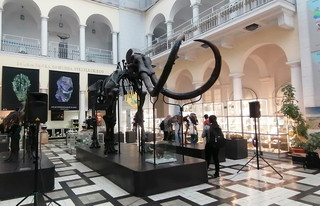This year, the annual meeting of the Paläontologische Gesellschaft was a joint meeting with the Polish Paleobiologists at the University of Warsaw (Faculty of Biology and Faculty of Geology). The topic of this year’s conference was ‘More than extinct species: the importance of fossils for ecology, evolution and conservation across borders?’. Besides seven workshops focusing primarily on methodological issues and three field trips to the Holy Cross Mountains, the Cretaceous-Paleogene boundary and Jurassic lagoon deposits, nearly 123 oral and 45 poster presentations informed about the latest research. About 160 participants from 17 countries attended the conference, most of them from Germany and Poland. Nearly 40% of the participants were early-career researchers.
During the conference, I had the opportunity to present a poster entitled ‘The role of hinge types in the Parallelodontidae (Bivalvia) and their significance in the arcoid classification’, with preliminary results on the different hinge morphology of Palaeozoic parallelodontids, which so far is unknown and much more difficult than previously thought. I had interesting discussions with colleagues about the topic and the possible resolutions of any problems along the way. Apart from my own topic, I followed and read about several others subjects, such as fossils in amber, mollusk palaeontology, biostratigraphy, vertebrates, and fishes, floras and the possibilities offered by AI in palaeontology, such as identifying fossils from photographs. Additionally, three public outreach lectures in Polish, German and English were organized to open the conference to a larger audience. The exchange during the social events such as coffee breaks, evening dinners, icebreaker and conference dinner have been very informal and interesting to become known to other researchers and early-career scientists. However, one of the highlights was certainly the icebreaker at the old Geological Museum of the State Geological Institute. Lovely skeletons and reconstructions of mammals and dinosaurs created a nice atmosphere for the evening.
All in all, the weather was great, the people were very pleasant, and the conference a positive event. It was great to meet some old scientific friends but also to meet new researchers during the conference.
I like to thank the Graduate School of Geosciences for financial support which allowed me to attend this conference.
Julia C. Friedel
PhD student
Institute of Geology and Mineralogy
PhD project: “How to build an ark - Understanding the evolutionary success of the Arcoidea
(Bivalvia)”
Poster title: “The role of hinge types in the Parallelodontidae (Bivalvia) and their significance in
the arcoid classification“
